steering wheel PONTIAC GRAND AM 2003 Owners Manual
[x] Cancel search | Manufacturer: PONTIAC, Model Year: 2003, Model line: GRAND AM, Model: PONTIAC GRAND AM 2003Pages: 354, PDF Size: 16.3 MB
Page 63 of 354
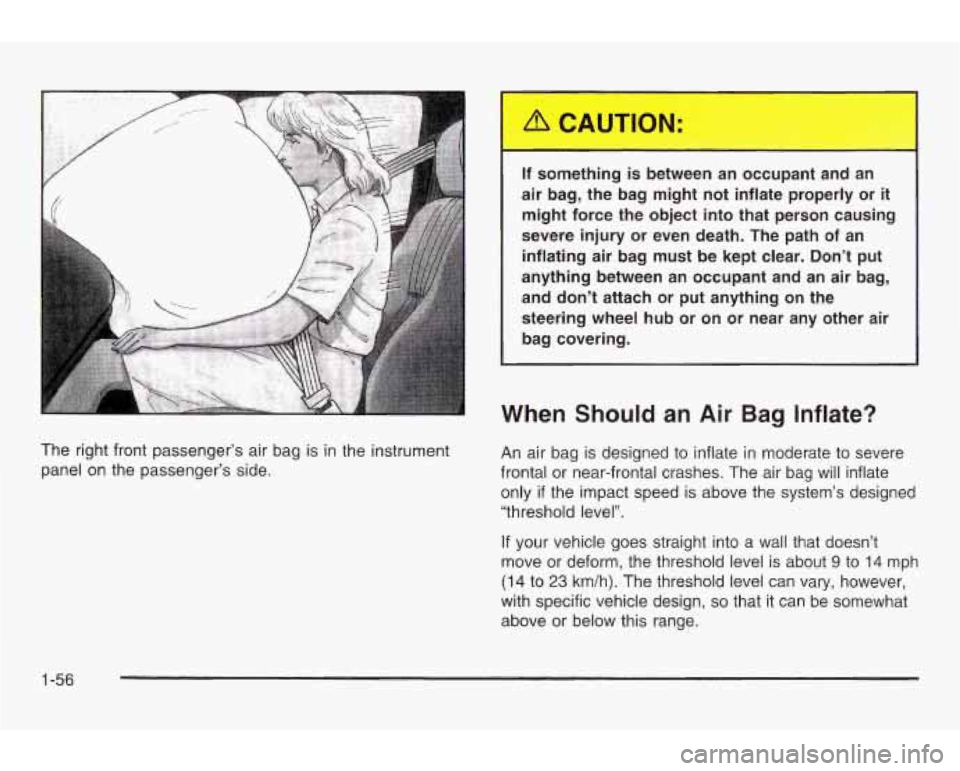
The right front passenger’s air bag is in the instrument
panel on the passenger’s side.
If something is between an occupant and an
air bag, the bag might not inflate properly or it
might force the object into that person causing
severe injury
or even death. The path of an
inflating air bag must be kept clear. Don’t put
anything between
an occupant and an air bag,
and don’t attach or put anything on the
steering wheel hub or on or near any other air
bag covering.
When Should an Air Bag Inflate?
An air bag is designed to inflate in moderate to severe
frontal or near-frontal crashes. The air bag will inflate
only
if the impact speed is above the system’s designed
“threshold level”.
If your vehicle goes straight into a wall that doesn’t
move or deform, the threshold level is about
9 to 14 mph
(14 to 23 km/h). The threshold level can vary, however,
with specific vehicle design,
so that it can be somewhat
above or below this range.
1-56
Page 64 of 354
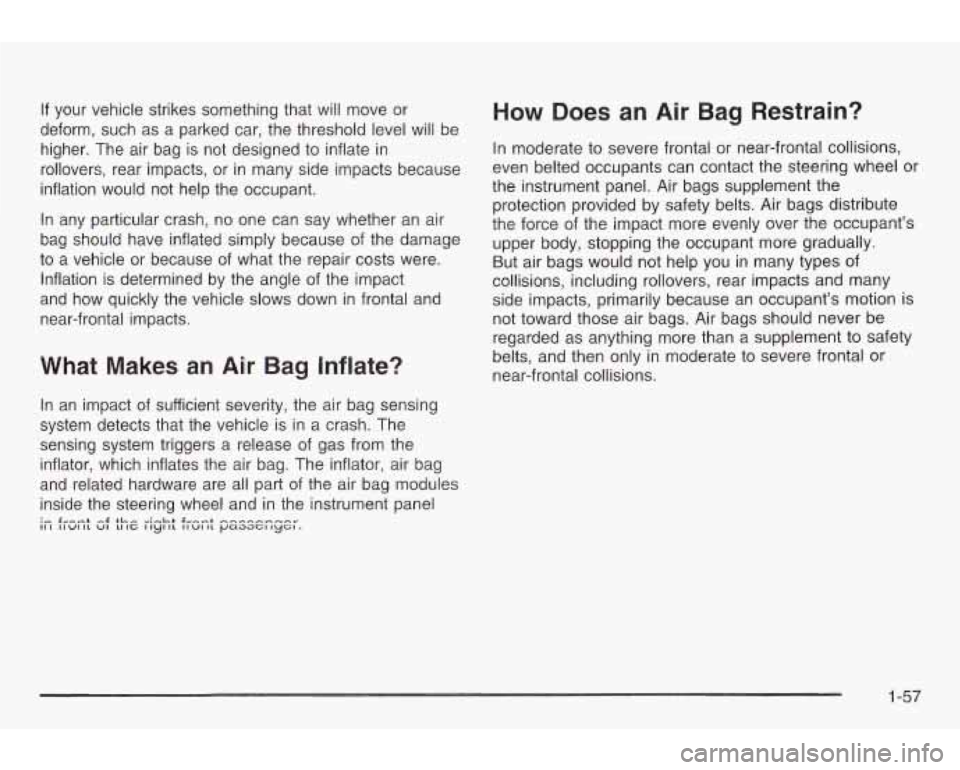
if your vehicle strikes something that will move or
deform, such as a parked car, the threshold level will be
higher. The air bag is not designed
to inflate in
rollovers, rear impacts, or in many side impacts because
inflation would not help the occupant.
In any particular crash, no one can say whether an air
bag should have inflated simply because of the damage
to a vehicle or because of what the repair costs were.
Inflation is determined by the angle of the impact
and how quickly the vehicle slows down in frontal and
near-frontal impacts.
What Makes an Air Bag Inflate?
In an impact of sufficient severity, the air bag sensing
system detects that the vehicle is in a crash. The
sensing system triggers a release of gas from the
inflator, which inflates the air bag. The inflator, air bag
and related hardware are all part of the air bag modules
inside the steering wheel and in the instrument panel
:- $*--+ ,$ +he -:ah& $we-+ ----_-.-_c III IIWIIL VI LIIC IIYIIL IIWIIL pacmr;r~y~~.
How Does an Air Bag Restrain?
In moderate to severe frontal or near-frontal collisions,
even belted occupants can contact the steering wheel or
the instrument panel. Air bags supplement the
protection provided by safety belts. Air bags distribute
the force of the impact more evenly over the occupant's
upper body, stopping the occupant
more gradually.
But air bags would not help you in many types of
collisions, including rollovers, rear impacts and many
side impacts, primarily because an occupant's motion is
not toward those air bags. Air bags should never be
regarded as anything more than a supplement
to safety
belts, and then only in moderate
to severe frontal or
near-frontal collisions.
1-57
Page 65 of 354

What Will You See After an Air Bag
Inflates?
After an air bag inflates, it quickly deflates, so quickly
that some people may not even realize the air bag
inflated. Some components of the air bag module
- the
steering wheel hub for the driver’s air bag or the
instrument panel for the right front passenger’s
bag
- will be hot for a short time. The parts of the bag
that come into contact with you may be warm, but
not too hot to touch. There will be some smoke and dust
coming from the vents in the deflated air bags. Air
bag inflation doesn’t prevent the driver from seeing or
being able to steer the vehicle, nor does it stop
people from leaving the vehicle. When
an air bag inflates, there is dust in the
air. This dust could cause breathing problems
for people with a history of asthma or other
breathing trouble.
To avoid this, everyone in
the vehicle should get out as soon
as it is safe
to do
so. If you have breathing problems but
can’t get out
of the vehicle after an air bag
inflates, then get fresh air by opening a
window or a door.
In many crashes severe enough to inflate an air bag,
windshields are broken by vehicle deformation.
Additional windshield breakage may also occur from the
right front passenger air bag.
Air bags are designed to inflate only once. After an
air bag inflates, you’ll need some new parts for
your air bag system.
If you don’t get them, the air
bag system won’t be there to help protect you
in another crash.
A new system will include air bag
modules and possibly other parts. The service
manual for your vehicle covers the need to replace
other parts.
1-58
Page 66 of 354
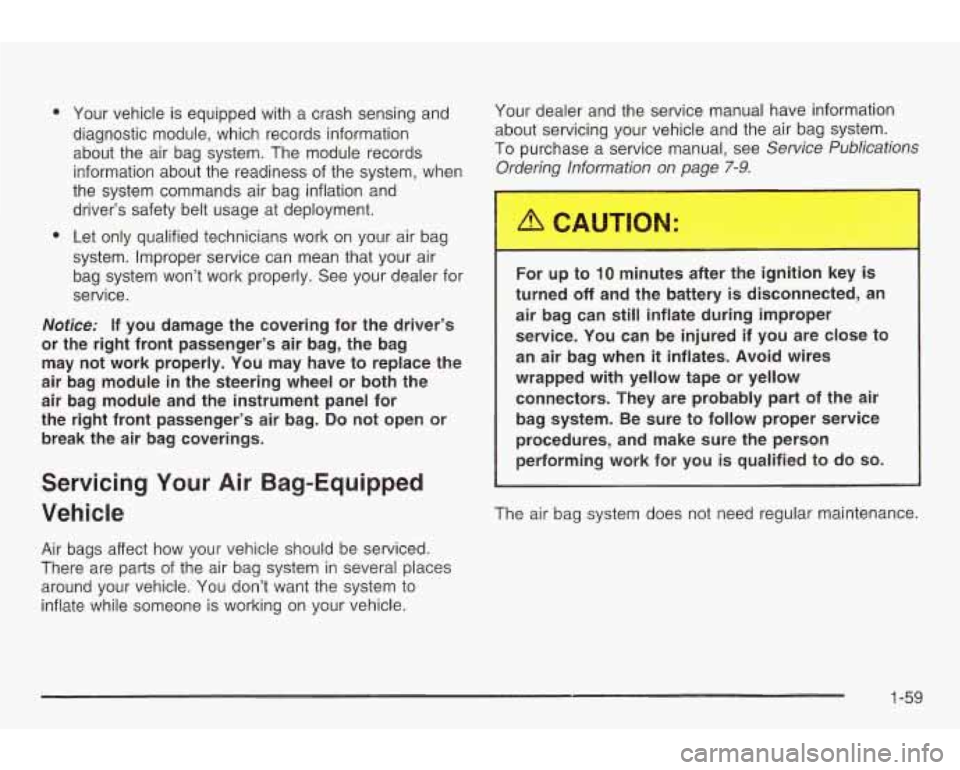
Your vehicle is equipped with a crash sensing and
diagnostic module, which records information
about the air bag system. The module records
information about the readiness of the system, when
the system commands air bag inflation and
driver’s safety belt usage at deployment.
Let only qualified technicians work on your air bag
system. Improper service can mean that your air
bag system won’t work properly. See your dealer for
service.
Notice: If you damage the covering for the driver’s
or the right front passenger’s air bag, the bag
may not work properly. You may have to replace the
air bag module in
the steering wheel or both the
air bag module and the instrument panel for
the right front passenger’s air bag. Do not open or
break
the air bag coverings.
Servicing Your Air Bag-Equipped
Vehicle
Air bags affect how your vehicle should be serviced.
There are parts of the air bag system in several places
around your vehicle. You don’t want the system to
inflate white someone is working on your vehicle. Your dealer and
the service manual have information
about servicing your vehicle and the air bag system.
To purchase a service manual, see Service Publications
Ordering Information on page
7-9.
For up to 10 minutes after the ignition key is
turned
off and the battery is disconnected, an
air bag can
still inflate during improper
service. You can be injured
if you are close to
an air bag when
it inflates. Avoid wires
wrapped with yellow tape or yellow connectors. They are probably part of the air bag system. Be sure to follow proper service
procedures, and make sure the person
performing work for you is qualified to do
so.
The air bag system does not need regular maintenance.
1-59
Page 110 of 354
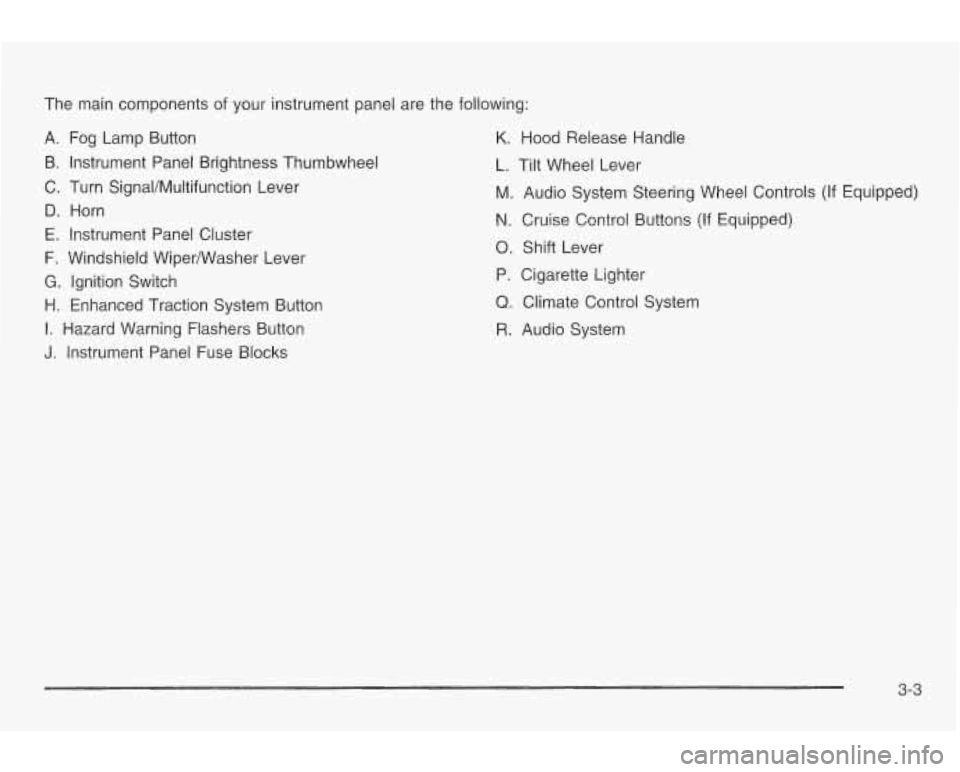
The main components of your instrument panel are the following:
A. Fog Lamp Button
B. Instrument Panel Brightness Thumbwheel
C. Turn SignaVMultifunction Lever
D. Horn
E. Instrument Panel Cluster
F. Windshield WiperNVasher Lever
G. Ignition Switch
H. Enhanced Traction System Button
I. Hazard Warning Flashers Button
J. Instrument Panel Fuse Blocks
K. Hood Release Handle
L. Tilt Wheel Lever
M. Audio System Steering Wheel Controls (If Equipped)
N. Cruise Control Buttons (If Equipped)
0. Shift Lever
P. Cigarette Lighter
Q. Climate Control System
R. Audio System
3-3
Page 112 of 354
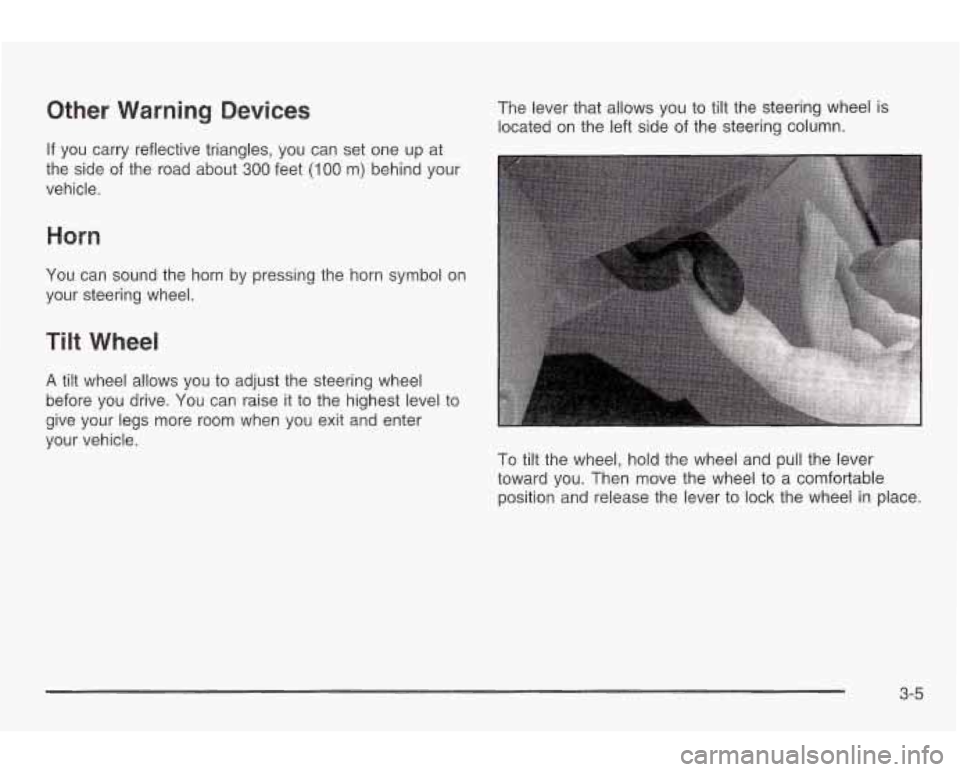
Other Warning Devices
If you carry reflective triangles, you can set one up at
the side
of the road about 300 feet (I00 m) behind your
vehicle.
Horn
You can sound the horn by pressing the horn symbol on
your steering wheel.
Tilt Wheel
The lever that allows you to tilt the steering wheel is
located on the left side of the steering column.
A tilt wheel allows you to adjust the steering wheel
before you drive. You can raise it to the highest level to
give your legs more room when you exit and enter
your vehicle.
To tilt the wheel, hold the wheel and pull the lever
toward you. Then move the wheel
to a comfortable
position and release the lever to
lock the wheel in place.
3-5
Page 116 of 354

Windshield Washer
To wash your windshield, press the button at the end of
the stalk until the washers begin.
In freezing weather, don't use your washer
until the windshield
is warmed. Otherwise the
washer fluid can form ice on the windshield,
blocking your vision.
Cruise Control
When you release the button, the washers will stop, but
the wipers will continue to wipe for about three times
or will resume the speed you were using before.
If your vehicle has this feature, the cruise control
buttons are located on the bottom of the steering wheel.
With cruise control, you can maintain a speed of
about
25 mph (40 km/h) or more without keeping your
foot on the accelerator. This can really help
on long trips.
Cruise control does not work at speeds below
25 mph (40 km/h).
3-9
Page 122 of 354

Headlamps Off in Park (P) Fog Lamps
To turn the headlamps off when it is dark outside, turn
the exterior lamps control
to the parking lamp position.
In this position, the parking lamps, sidemarker lamps,
taillamps, license plate lamps and instrument panel
lights will be on, but the headlamps will be
off.
To turn on the headlamps along with the other lamps
when it is dark outside, turn the exterior lamps control
to
the AUTO or headlamp position.
Delayed Headlamps
The delayed headlamps feature will continue to
illuminate the headlamps for 20 seconds after the key is
turned to OFF, then the headlamps will automatically
turn
off.
To override the 20 second delayed headlamp feature
while
it is active turn the turn signaVmultifunction
lever up one position and then back
to AUTO. If
your vehicle has this
feature, the button for your
fog lamps is located on
the instrument panel,
to the
left of the steering wheel,
beside the instrument
panel brightness
thumbwheel.
When using the fog lamps, the ignition must be on as
well as the parking lamps or the low-beam headlamps.
Press the button
to turn the fog lamps on. An indicator
light on the button will glow when the fog lamps are on.
Press the button again
to turn the fog lamps off. The
fog lamps will turn
off whenever the high-beam
headlamps are turned on. When the high beams are
turned
off, the fog lamps will come on again.
3-1 5
Page 123 of 354
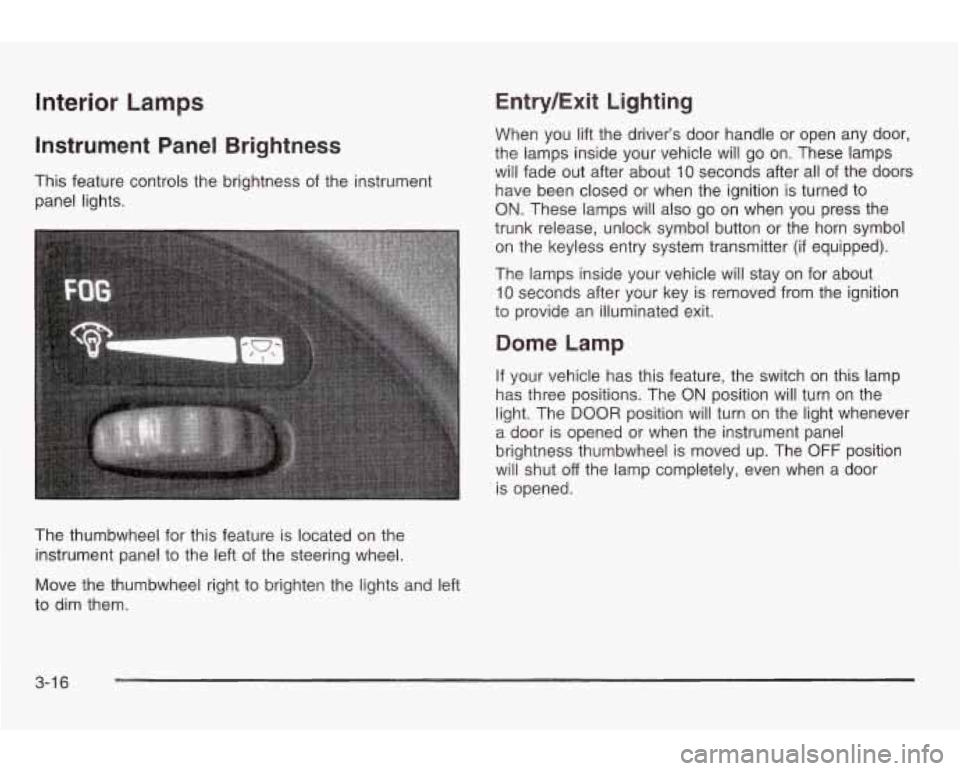
Interior Lamps
Instrument Panel Brightness
This feature controls the brightness of the instrument
panel lights.
The thumbwheel for this feature
is located on the
instrument panel
to the left of the steering wheel.
Entry/Exit Lighting
When you lift the driver’s door handle or open any door,
the lamps inside your vehicle will go on. These lamps
will fade out after about
10 seconds after all of the doors
have been closed or when the ignition is turned to
ON. These lamps will also go on when you press the
trunk release, unlock symbol button or the horn symbol on the keyless entry system transmitter (if equipped).
The lamps inside your vehicle will stay on for about
10 seconds after your key is removed from the ignition
to provide an illuminated exit.
Dome Lamp
If your vehicle has this feature, the switch on this lamp
has three positions. The
ON position will turn on the
light. The
DOOR position will turn on the light whenever
a door is opened or when the instrument panel
brightness thumbwheel is moved up. The OFF position
will shut
off the lamp completely, even when a door
is opened.
Move the thumbwheel right
to brighten the lights and left
to dim them.
3-1 6
Page 176 of 354
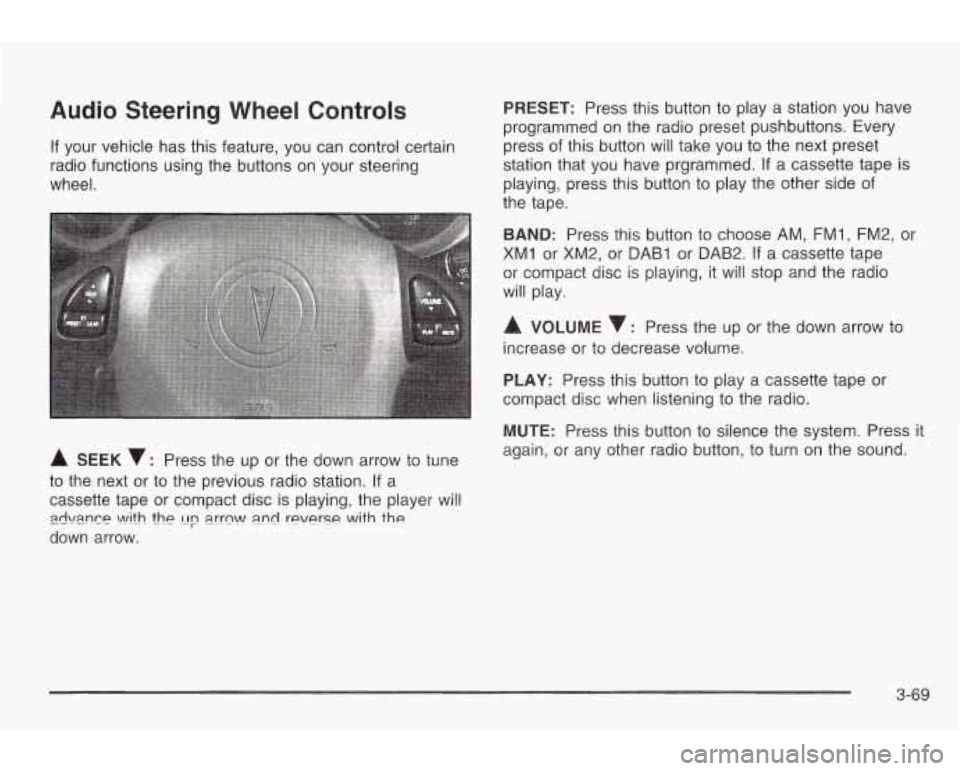
Audio Steering Wheel Controls
If your vehicle has this feature, you can control certain
radio functions using the buttons on your steering
wheel.
A SEEK v: Press the up or the down arrow to tune
to the next or to the previous radio station. If a
cassette tape or compact disc is playing, the player will
down arrow.
zwi\mn~~ \A!ith thp [Ip a.rrn\A/ a.nd reverse with the
PRESET: Press this button to play a station you have
programmed on the radio preset pushbuttons. Every
press of this button will take you to the next preset
station that you have prgrammed.
If a cassette tape is
playing, press this button to play the other side of
the tape.
BAND: Press this button to choose AM, FMI, FM2, or
XM1 or XM2, or DAB1 or DAB2. If a cassette tape
or compact disc is playing, it will stop and the radio
will play.
A VOLUME : Press the up or the down arrow to
increase or to decrease volume.
PLAY: Press this button to play a cassette tape or
compact disc when listening to the radio.
MUTE: Press this button
to silence the system. Press it
again, or any other radio button, to turn on the sound.
3-69